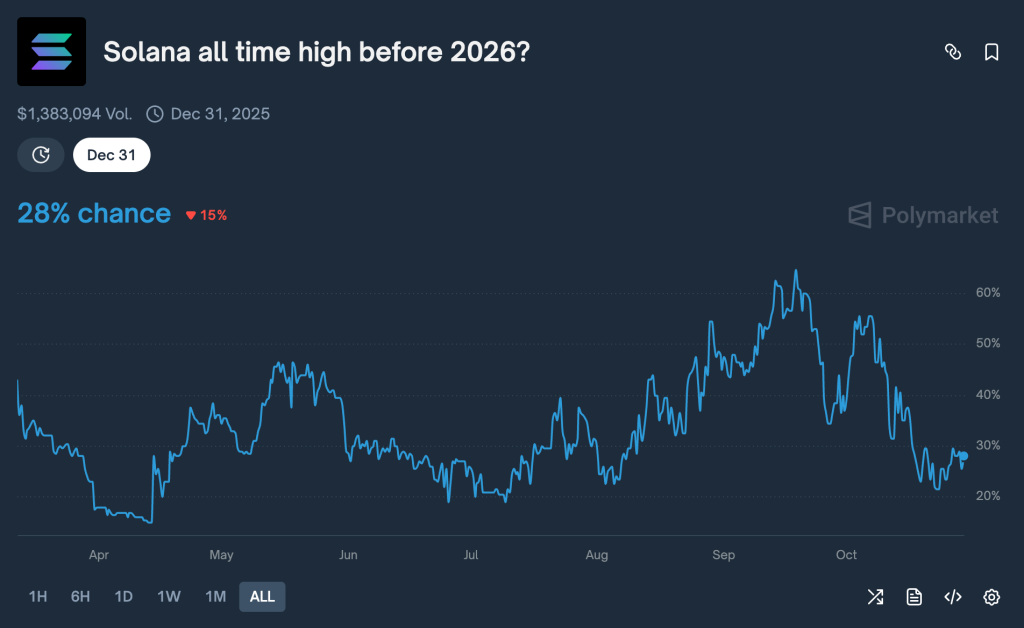Grayscale Investments launched its Solana Trust the ETF on NYSE Arca on Tuesday, becoming the first of the company’s staking products to be listed under the new generic listing standards approved by the SEC.
The move intensifies competition in the nascent Solana ETF market, where Bitwise’s debut product has already captured $69.5 million in inflows on its first day.
Launch extends Grayscale’s range of digital assets beyond Bitcoin And Ethereumoffering investors exposure to Solana’s proof-of-stake blockchain via a familiar exchange-traded wrapper.
GSOL now joins Bitwise’s BSOL and Rex-Osprey’s SSK as the third Solana ETF traded on US exchanges.
Grayscale enters with a staking-friendly structure
GSOL has an expense ratio of 0.35% and holds 525,387 SOL tokens, 74.89% of which are currently staked to generate network rewards.
Grayscale intends to pass on 77% of all staking rewards to investors on a net basis, potentially adding 5-6% in annual returns based on Solana’s historical staking returns of 6-8%.
The fund first launched as a private trust in 2021, was listed on OTCQX in 2023 and began investing in October 2025.
Inkoo Kang, senior vice president of ETFs at Grayscale, touted the launch as proof that digital assets belong “modern wallets» alongside traditional stocks and bonds.
Kristin Smith, president of the Solana Policy Institute, also noted that staking ETPs allows investors “to help secure the network, accelerate innovation for developers, and earn rewards on one of the fastest growing assets in modern finance.”
The product is not registered under the Investment Company Act of 1940, meaning it does not have the regulatory protections of traditional ETFs and mutual funds.
Grayscale emphasized that GSOL represents indirect exposure to Solana and carries significant risks, including potential loss of capital.
Bitwise Dominates Early Solana ETF Flows
Bitwise’s Solana ETF captured $69.5 million in its Oct. 28 debut, nearly six times the $12 million raised by Rex-Osprey’s competing product.
BSOL is staking 100% of its internally held SOL tokens to provide investors with the full return of Solana’s network, charging a 0.20% management fee which has been waived for the first three months.
Matt Hougan, Bitwise’s chief investment officer, attributed institutional enthusiasm to Solana’s on-chain revenue leadership.
“Institutional investors love ETFs and income,” he said.
Rex-Osprey’s SSK takes a different approach, owning 54% in Solana direct, 43.5% in a Swiss-listed CoinShares ETP and the remainder in JitoSOL and cash, with monthly staking rewards classified as return of capital for tax purposes.
Despite positive sentiment towards ETFs, the market remains cautious about near-term price action.
Traders on Polymarket give Solana just a 28% chance of hitting a new all-time high before 2026, with SOL trading at $200 today, up almost 1% over 24 hours.

Solana Challenges Ethereum’s Institutional Dominance
Speaking to Cryptonews, Maria Carola, CEO of StealthEX, considers the launch of Solana ETF a defining moment in the battle for layer 1 blockchain dominance.
“The launch of a spot ETF on Solana is a signal that has erupted in the long battle for dominance in the layer 1 blockchain space,” she said.
“For the first time, institutional investors are invited to consider Solana as a standalone macro asset.“
Carola notes that projections of $3 billion in ETF inflows over the next 12 to 18 months depend on Solana maintaining its 2024 momentum in DeFi expansion and network stability.
She acknowledges that while Solana offers technological advantages in terms of speed and scalability, “it is Ethereum’s fundamentals, such as stability, institutional reputation and integration into the global financial system, that maintain its leadership.»
Ethereum currently has over $60 billion locked in DeFi with a mature staking ecosystem that continues to set the standard for institutional investors seeking predictability and reliability.
However, Carola suggests a potential coexistence model where “Ethereum serves as the underlying trust and settlement layer in the on-chain economy, while Solana becomes its high-performance execution engine..”
She adds that if the ETF inflow projections come true by the end of 2025, “Solana could become the first blockchain since Ethereum to break the institutional glass ceiling.“
Regulatory dynamics are growing across multiple blockchains
The wave of Solana ETFs follows Hong Kong’s October approval of China Asset Management’s SOL spot fund, which began trading on October 27 with a minimum investment of $100.
The product carries a management fee of 0.99% and a total expense ratio of 1.99%, making Solana the third cryptocurrency, after Bitcoin and Ethereum, to receive one-time ETF authorization in the territory.
Several U.S. issuers, including VanEck, Canary Capital, Franklin Templeton, Fidelity and CoinShares, have also received approval for Solana ETF proposals.
Recently, Bloomberg analyst Eric Balchunas also confirmed that the SEC is expected to approve the first Hedera and Litecoin ETFs, with listing notices for Canary’s HBAR and LTC products scheduled for October 28.
The post Solana ETF Race Intensifies as Grayscale Joins Bitwise on Wall Street appeared first on Cryptonews.





 Convenient Solana exposure coupled with staking benefits.
Convenient Solana exposure coupled with staking benefits.  Exposure to high-throughput, low-cost blockchain.…
Exposure to high-throughput, low-cost blockchain.…  SEC Set to Approve HBAR ETF — Hedera’s Gregg Bell Calls It a ‘New Chapter’ for Regulated Crypto Access, Marking the First Time Investors Can Get Exposure to the ETF
SEC Set to Approve HBAR ETF — Hedera’s Gregg Bell Calls It a ‘New Chapter’ for Regulated Crypto Access, Marking the First Time Investors Can Get Exposure to the ETF